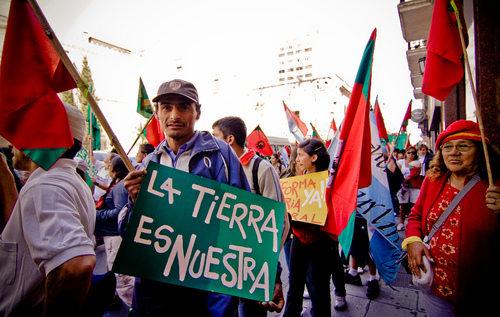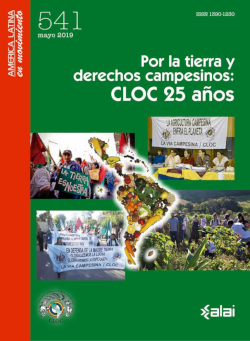The agrarian question and current challenges
We must centre our efforts on production of healthy food, based on agroecology for Food Sovereignty.
- Opinión

| Article published in ALAI’s magazine No. 541: Por la tierra y derechos campesinos: CLOC 25 años 09/05/2019 |
The land is ours
Throughout history, the progressive transformation of farm production has had as its basis the struggle for land. This struggle seeks to radically change the productive structure; consequently, the agrarian question is paramount in the coexistence of humanity and was assumed as such by the classic thinkers of social struggle.
In this context, agrarian reform began with liberal economic ideas, such as voluntary sale of land to poor farmers. Only over the last century was it transformed into a concept based on the coercion of the power of the State; we might say that it is an unfinished task of capitalism. It is therefore up to the farmer and indigenous movements to put this problem at the centre of our struggle against the ruling system.
To reactivate agriculture together with the farmers is vital for cooling the planet and thus resolving the problem of hunger in the world. Studies by the Action Group on Erosion, Technology and Concentration (ETC Group), consider that peasant farming produces 70 per cent of the food in the world, on 25 per cent of the land, while agribusiness, in order to produce only 25 per cent of the food, occupies 75 per cent of the land.
This research counters the myths of industrial and genetically modified (GM) agriculture. The study insists that, if governments want to end hunger and put a brake on climate change, they should apply public policies to promote peasant farming.
We all remember that a historic fact changed the modern world: the Spanish conquest of Abya Yala, combined with the exploitation of the resources of the colonies in Africa and Asia. In the new colonies, an unprecedented concentration of land was established, and it was therefore a key factor for the agenda of independence movements.
Thus, in the course of our history, memorable milestones have been registered such as the Artiguista Revolution (José Gervasio Artigas) that in Argentina, between 1811 and 1820, set off a process of distribution of land, that some historians have interpreted as a radical and popular “agrarian reform”.
Similarly, Simon Bolivar and Francisco Morazan gave land to their troops; then Emiliano Zapata and Pancho Villa (1912 - 1917) assumed the old Russian watchword of the Nartodnik populists: “Land and freedom”; and finally, in the second half of the last century, the struggle for Agrarian Reform took shape.
This struggle is still alive due to the intensification of the concentration of land, using old forms with new names, such as land-grabbing and extractivism, monoculture and agri-business.
The grab for land and life
The origin of the large estate and agrarian property comes from the arrival of the Spanish in America, with the imposition of a colonial system that massacred, enslaved and usurped the vast and fertile lands that the native peoples occupied.
In the face of such exploitation, in Mexico, Pancho Villa and Emiliano Zapata took up arms. These two revolutionaries overthrew Porfirio Diaz and reorganized property of land across the country, thus promoting the first agrarian reform in the continent.
This revolutionary process marked a trail, which was followed by the Bolivian Revolution in 1952 and the Cuban Revolution in 1959.
While Mexico, in 1917, promoted its agrarian reform with the peasant cry for “Land and freedom”, in Europe, the Russian Revolution produced great economic, social and political transformations, including a change in the system of property and land holding.
The process of agrarian reform of the Russian Revolution extended across various countries of Europe, such as Austria, Germany, Poland and others. In 1949, the Revolution of the Peoples’ Republic of China set off a radical agrarian reform with the idea of nationalizing all the means of production and the land.
In 1961, the United States began a counter campaign to detain the social mobilization that was taking place in the Americas and President John F. Kennedy promoted the Alliance for Progress, summoning the countries of the continent to a meeting in Punta del Este, to promote the distribution of land in the American republics.
The Alliance for Progress sought to reduce the large estates through a just distribution of property. In adopting the agrarian reform, the governments pursued various goals, among them a higher rate of agricultural growth, by encouraging the landowners to undertake modernization, industrialization and commercialization of inputs. On the other hand, where the property was not managed efficiently, this led simply to its expropriation.
So the economic objective underlying agrarian reform was to accelerate the process of industrialization of these countries. The scope of the agrarian reform in Latin America varied enormously, both with respect to the quantity of land expropriated and the number of peasant-farmers who benefitted.
In any case, facing the worldwide phenomena of global warming, poverty, centralization of wealth, land-grabbing, agrarian policies, processes of transformation and reinvention of productive sectors, these are the matters that should be addressed with urgency and commitment.
The farmer movements constitute a social force with a conscience, that promotes economic alternatives to achieve the survival of the planet and quality of life for millions of people in the world.
Equality of access to land
The equality of men and women in access to land is a fundamental objective to overcome discrimination and the imposition of the machista and patriarchal system that for centuries has made rural women invisible, relegating them simply to a reproductive role. Here we propose that for a true emancipation of women, they should have a leading role in the redistribution of land, with full participation and integration in all processes of development in the systems and ways of life in the countryside.
Similarly, throughout history, women have been the collectors and guardians of seeds, protectors and promoters of biodiversity, guarantors of food sovereignty and ancestral knowledge; we therefore propose an integral and inclusive agrarian reform for good living.
Challenges
The first challenge: to transform the struggle for land and territory. It is not only a place of work, it should be assumed as a collective necessity, a space of collective organization of the peasant class, as a space of resistance against capital.
The second challenge: to build a new model of production of agriculture itself, for which we must have a strategic program that goes beyond immediate needs.
How will we use our land? What social function do we give to the land?
We should underline that we must centre our efforts on production of healthy food, based on agroecology for Food Sovereignty. This concept should be popularized, socialized and above all, it is important for all organizations to assume this.
Also, we need to produce a new technological matrix, with specialized techniques that enable us to multiply and produce in harmony with nature.
The third challenge: to achieve public policies that support the proposals of peasant-farmer movements in all areas: agriculture, housing, education, infrastructure, culture, etc.
The fourth challenge: to develop permanent processes of political and ideological education, since there is a deficiency of training in the left at a global level. The organizations face the challenge of building processes and spaces of political education linked to the struggles of our organizations, and that allow for creation of autonomous spaces for women, youths and different sexual identities.
The fifth challenge: to establish our own popular media with outreach to the people, that present our projects to society, that cover different issues such as the dialogue with our own grassroots and our society, as a mechanism for winning over hearts and minds.
The sixth challenge: to build an alliance with other social sectors in the countryside, with other organizations that struggle in the territories, such as indigenous peoples; to better identify our allies.
The seventh challenge: joint mobilizations at an international level against our enemies, as well as undertaking actions on strategic dates.
The eighth challenge: to strengthen militant internationalist solidarity, seeking creative ways of putting solidarity into practice, seeking to mobilize the capacity for indignation. Because if we can feel indignation towards any abusive treatment that another person suffers in any part of the world, then we are companions.
The ninth challenge: to promote the global campaign for a peoples’ agrarian reform; since 1996, this campaign has been supporting local struggles, intervening against the violations of human rights, disseminating information from national and local movements through investigative missions, undertaking international lobbying tours promoted by observatories of the peasant and indigenous struggle.
We recently took part in a meeting of the collective Land, Water and Territory. There our principal agreement was to relaunch the Global Campaign for Agrarian Reform, during the 7th Congress of the Latin American Coordination of Rural Organizations (CLOC/Vía Campesina) in Cuba (June 2019), where we will draw up a plan of action for the continent to make the Integral and Popular Agrarian Reform visible as the basis for Food Sovereignty and Agroecology as part of the decade of peasant family farming.
(Translated for ALAI by Jordan Bishop)
Fausto Torrez is Secretary of International Relations of the Association of Rural Workers (ATC-Nicaragua).
Elsa Nury Martínez is President of the National Federation of Agricultural and Livestock Unions (FENSUAGRO - Colombia).
Del mismo autor
- La question agraire et les défis actuels 18/06/2019
- The agrarian question and current challenges 27/05/2019
- La cuestión agraria y los desafíos actuales 21/05/2019
- La situación de Nicaragua 02/07/2018
- Algunas ideas de lo que pasa en Nicaragua 09/05/2018
- Partido Libertad y Refundación, Libre, el gran ganador de las elecciones 27/11/2013
- Vía Campesina se reúne con el Presidente Evo Morales 22/04/2010
- Por uma Reforma Agrária genuína, integral e participativa 23/02/2006
- Por una Reforma Agraria genuina, integral y participativa 21/02/2006
- Nicaragua aún existe 14/12/2005
Soberanía Alimentaria
- Gerson Castellano, Pedro Carrano 30/03/2022
- Silvia Ribeiro 29/03/2022
- Germán Gorraiz López 28/03/2022
- Silvia Ribeiro 16/02/2022
- Clara Sánchez Guevara 15/02/2022









